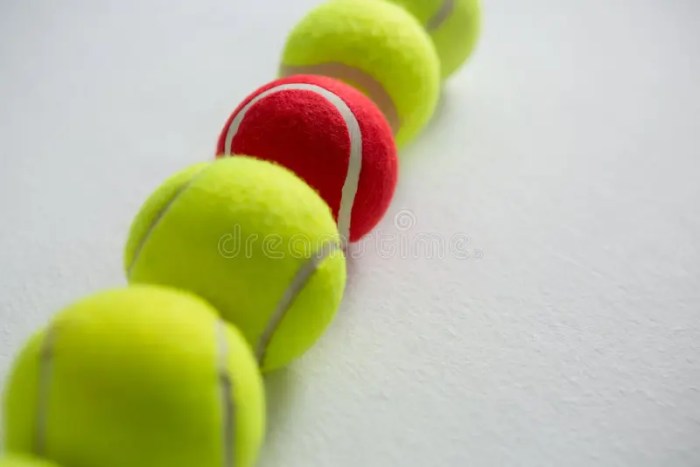Lay row of tennis balls, a seemingly simple concept, unveils a world of intricate details and fascinating insights. This guide delves into the purpose, techniques, and regulations surrounding the arrangement of tennis balls, exploring the impact of their characteristics and the dimensions of the court.
We’ll uncover the secrets of proper storage to maintain their quality and delve into the diverse uses of tennis balls beyond the realm of the tennis court.
Join us on this engaging journey as we unravel the fascinating world of lay row of tennis balls, leaving no stone unturned in our quest for knowledge and inspiration.
Tennis Balls Arrangement: Lay Row Of Tennis Balls

Arranging tennis balls in a row serves several purposes. It helps organize and store the balls, making them easily accessible during practice or gameplay. Additionally, it allows for efficient drying of the balls after cleaning or playing in wet conditions.
There are various ways to arrange tennis balls in a row. One common method is to simply line them up side by side, either in a straight line or a curved shape. Another option is to stack the balls on top of each other, forming a pyramid or tower-like structure.
Some people also prefer to arrange the balls in a pattern, such as a circle or a star shape.
Ball Arrangement Techniques, Lay row of tennis balls
- Linear Arrangement:Arranging the balls in a straight line is the most straightforward method. It provides easy access to each ball and allows for efficient drying.
- Curved Arrangement:Placing the balls in a curved shape can save space and create a more visually appealing display. It is also suitable for drying the balls, as it allows for better air circulation.
- Stacked Arrangement:Stacking the balls on top of each other forms a compact and stable structure. This method is ideal for storing a large number of balls in a limited space.
- Patterned Arrangement:Arranging the balls in a specific pattern, such as a circle or a star, adds a decorative touch to the storage area. It is often used for display purposes or to create a unique visual effect.
Tennis Ball Characteristics
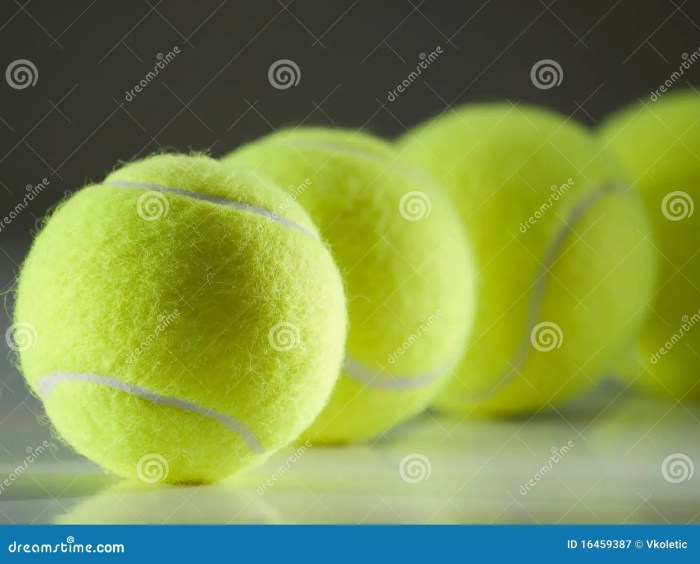
Tennis balls are an integral part of the game of tennis. Their design and construction play a crucial role in the performance of the ball and the overall gameplay. In this section, we will delve into the standard size and weight of a tennis ball, the materials used in its construction, and how these factors impact its performance.
Standard Size and Weight
According to the International Tennis Federation (ITF), the official size and weight of a tennis ball are strictly regulated. The ball must have a diameter of 6.54 cm (2.575 inches) and weigh between 56.0 and 59.4 grams (1.975 and 2.106 ounces).
Materials Used
Tennis balls are typically constructed using a combination of rubber and felt. The core of the ball is made of pressurized rubber, which provides the ball with its bounce and elasticity. The outer layer of the ball is covered with a felt material, which gives the ball its grip and durability.
Impact of Design on Performance
The design of a tennis ball significantly influences its performance. The pressurized rubber core provides the ball with its bounce and speed, while the felt cover affects the ball’s spin and trajectory. The ITF regulations ensure that tennis balls meet specific performance standards, ensuring consistency and fairness in the game.
Tennis Court Dimensions
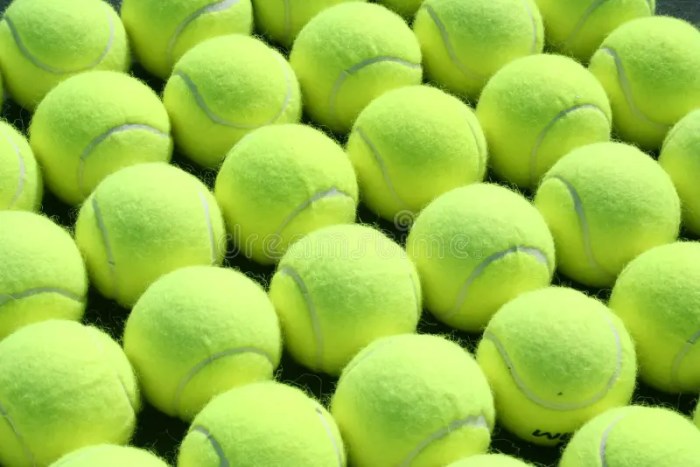
The dimensions of a standard tennis court play a crucial role in determining the layout and placement of tennis balls during a match. The court is rectangular in shape and consists of two equal-sized halves, separated by a net.
The overall dimensions of a standard tennis court are as follows:
- Length: 78 feet (23.77 meters)
- Width: 27 feet (8.23 meters) for singles matches and 36 feet (10.97 meters) for doubles matches
The dimensions of the court influence the layout of tennis balls in several ways:
- Baseline Placement:The baseline, which marks the back boundary of the court, is located 27 feet from the net for singles matches and 36 feet from the net for doubles matches. This distance determines the depth of the court and affects the placement of balls during groundstrokes.
- Service Court Dimensions:The service court, located on each side of the net, is 21 feet long and 13.5 feet wide for singles matches and 21 feet long and 18 feet wide for doubles matches. The size of the service court influences the placement of serves and affects the strategy of both the server and the receiver.
In addition to the overall dimensions of the court, there are also specific regulations regarding the placement of tennis balls on the court:
- In Bounds:A ball is considered in bounds if it lands within the boundaries of the court, including the sidelines and baselines.
- Out of Bounds:A ball is considered out of bounds if it lands outside the boundaries of the court, including the sidelines, baselines, or the net.
- Net Fault:A ball that touches the net during a serve is considered a net fault and is replayed.
- Foot Fault:A foot fault occurs when a player’s foot touches the baseline before they hit the ball during a serve. A foot fault results in a loss of the point.
These regulations ensure fair play and help to maintain the integrity of the game.
Visualize a lay row of tennis balls, each ball representing a complex system within the human body. Studying the lay row can help you grasp the fundamentals of anatomy and physiology. For a deeper understanding, explore a&p exam 1 chapters 1-3 , where you’ll delve into the intricacies of the body’s structure and function.
As you return to the lay row of tennis balls, you’ll appreciate the intricate symphony of cells, tissues, and organs that make up the human body.
Tennis Ball Storage
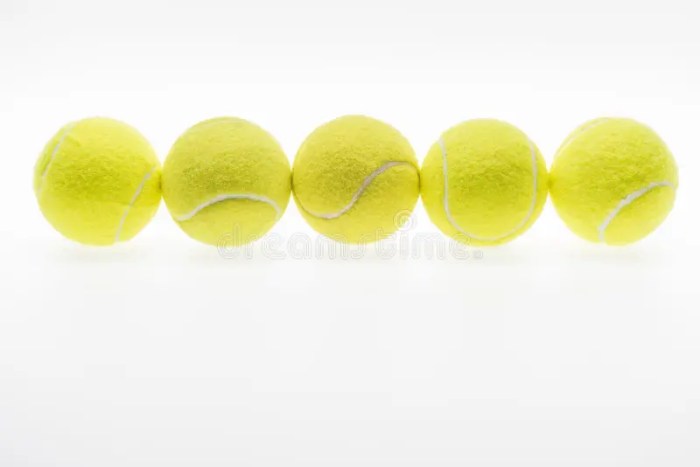
Proper tennis ball storage is crucial to maintain their quality and performance. Balls exposed to extreme temperatures or humidity can lose their bounce and become less playable.
Tips for Storing Tennis Balls
- Keep them in a cool, dry place:Avoid storing balls in hot garages, attics, or damp basements. Ideal temperatures range between 55-75°F (13-24°C), with humidity below 60%.
- Use a pressurized ball can:Store unopened cans in a cool, dry place. Once opened, keep the balls in the can with the lid tightly sealed to maintain pressure and prevent air exposure.
- Avoid extreme temperature fluctuations:Sudden changes in temperature can damage the ball’s rubber core. Keep them away from heaters or direct sunlight.
Tennis Ball Use
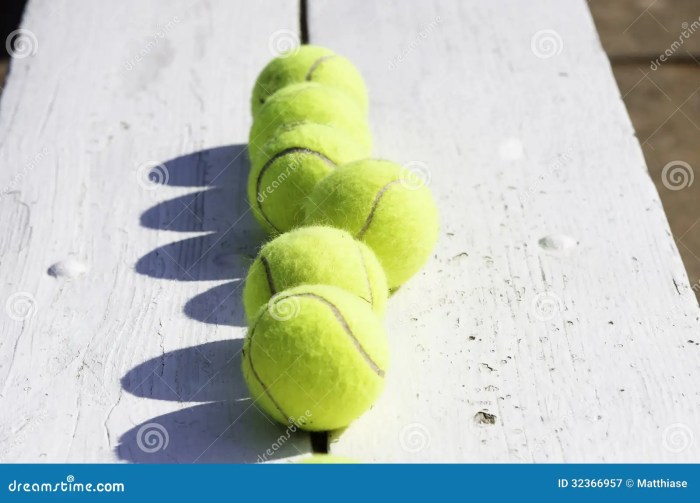
Tennis balls are not just for playing tennis. They have a variety of other uses, both practical and creative.
Practical Uses
- Stress Relief:Squeezing a tennis ball can help relieve stress and tension.
- Hand Strengthener:Grip strengthening exercises using tennis balls can improve hand strength and dexterity.
- Pet Toy:Many dogs love to play with tennis balls, which can provide them with exercise and mental stimulation.
- Cleaning:Tennis balls can be used to clean hard-to-reach areas, such as under furniture or inside appliances.
- Pest Control:Mothballs can be placed inside tennis balls and hung in closets or drawers to repel moths.
Creative Uses
- Juggling:Tennis balls are a great juggling prop, as they are soft and easy to grip.
- Art:Tennis balls can be used to create unique and colorful artwork, such as mosaics or sculptures.
- Photography:Tennis balls can be used as props in creative photography, adding a playful or whimsical touch to images.
- Home Decor:Tennis balls can be used to make decorative items, such as lampshades or wall art.
- Gardening:Tennis balls can be used to create raised garden beds or as supports for climbing plants.
Environmental Impact
Tennis balls are typically made from rubber, which is a non-biodegradable material. As a result, tennis balls can have a negative impact on the environment if they are not disposed of properly.
- Landfill Disposal:When tennis balls are disposed of in landfills, they can take hundreds of years to decompose.
- Recycling:Tennis balls can be recycled, but the process is complex and not widely available.
- Composting:Tennis balls cannot be composted, as the rubber material does not break down easily.
To reduce the environmental impact of tennis balls, it is important to dispose of them properly. One option is to donate used tennis balls to local schools or community centers. Another option is to recycle tennis balls through specialized recycling programs.
FAQ Compilation
What is the purpose of laying out tennis balls in a row?
Laying out tennis balls in a row serves several purposes. It allows players to easily visualize the trajectory of their shots, practice their aim, and develop consistency in their stroke.
What are the different ways to arrange tennis balls in a row?
Tennis balls can be arranged in a row in various ways, including straight lines, curves, and even patterns. The choice of arrangement depends on the specific drill or practice exercise being performed.
What are the dimensions of a standard tennis court?
A standard tennis court measures 78 feet (23.77 meters) long and 27 feet (8.23 meters) wide for singles matches, and 36 feet (10.97 meters) wide for doubles matches.
How does the size of a tennis ball affect its performance?
The size of a tennis ball directly impacts its weight, bounce, and flight characteristics. Larger balls tend to bounce higher and travel slower, while smaller balls have a lower bounce and faster flight speed.
What are the environmental implications of tennis ball disposal?
Tennis balls are typically made from synthetic materials, which can take hundreds of years to decompose in landfills. Proper disposal and recycling programs are essential to minimize the environmental impact of discarded tennis balls.
